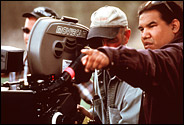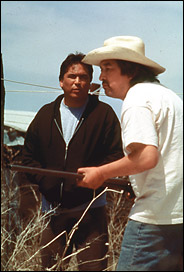September 29, 2002
By JOSHUA BROCKMAN
TAOS, N.M. — Although American Indians have played a prominent role in Hollywood movies, the reality of Indian country has rarely made it to the screen. Chris Eyre, with two new projects offering genuine, and sometimes raw, portraits of Indian life today, is helping Hollywood catch up.
His new film, “Skins,” which opened on Friday, was shot entirely on the Pine Ridge reservation in South Dakota and depicts alcoholism and violence in scenes that could be from a fly-on-the-wall documentary, or perhaps an episode of “Cops.”

Chris Eyre filming “Skins” on the Pine Ridge Reservation. “The only thing you get in making period pieces about Indians is guilt,” he says. First Look Pictures.
“I’m not interested in making movies about historical Indians, because there’s no value in that,” Mr. Eyre, 33, said at a screening of “Skins” last spring at the Taos Talking Picture Festival. “The only thing you get in making period pieces about Indians is guilt. I’m interested in doing what non-Indian filmmakers can’t do, which is portray contemporary Indians.”
Mr. Eyre’s previous feature, “Smoke Signals” (1998), won the Filmmakers Trophy at the Sundance festival and was the first movie by an American Indian director to be nationally released. In November his film of the Tony Hillerman novel “Skinwalkers,” from Mr. Hillerman’s popular series about the Navajo tribal policemen Jim Chee and Joe Leaphorn, will be the first American story shown as part of PBS’s “Mystery!”
“Chris has a very well-rounded sensibility in terms of business and storytelling,” said Bird Runningwater, a consultant to the Native American program at the Sundance Institute, which Mr. Eyre attended in 1995. “He knows good stories. He really gives complexity and depth to Native characters that he directs and brings to the screen. Couple that with a knowledge of how the movie world works.”
Mr. Eyre is not the only Indian filmmaker taking on subjects like alcohol abuse, murder, domestic violence and homosexuality. Zacharias Kunuk’s “Fast Runner,” released in June, and Sherman Alexie’s “Business of Fancydancing,” which is to open on Oct. 18, are also attacking the longstanding Hollywood clichés.
“They want the wise old grandfathers and they want the visions and they want the drunks,” said Mr. Alexie, 35, the writer and filmmaker who adapted the screenplay for “Smoke Signals” from his own short stories. “But they don’t want lawyers, doctors, construction workers, or members of A.A.”

Eric Schewig, left, and Graham Greene in “Skins.”
Even contemporary Hollywood depictions of Indians — in a well-meaning film like “Dances With Wolves,” for instance — are based on the old images, said Elizabeth Weatherford, head of the film and video center of the Smithsonian National Museum of the American Indian. “Always, the Hollywood films perceived the Indians as other,” she said. “The big difference is right there: Hollywood perceived its audiences as non-Native.”
Mr. Eyre’s goal is to recast the Indian experience with the Indian audience in mind.
“I’m talking about owning our image and debunking what we all grew up understanding from John Ford and John Wayne about movie Indians,” said Mr. Eyre, whose soft voice and casual appearance (Hawaiian shirt and sneakers) belied the intensity that emerged when he talked about his mission. “The only thing that has been more detrimental to Indians than religion has been John Ford movies.”
To make sure that “Skins” would be available to Indians, and responsive to their concerns, Mr. Eyre and First Look Pictures staged what they called the “Rolling Rez Tour.” Free screenings of the movie, before its theatrical release, were held at several Indian communities around the country, including Pine Ridge.
“Self-representation of Indians in cinema is one of the last cinematic frontiers left,” Mr. Eyre said. “We are in an infancy of illustrating to the world who it is that we are.”
“Skins,” which is based on a novel by Adrian C. Louis (the screenplay is by Jennifer D. Lyne), focuses on two brothers on the Pine Ridge reservation who are struggling to keep their boyhood promise to look out for each other. Mogie Yellow Lodge (Graham Greene), a highly decorated Vietnam veteran, is a chronic alcoholic. His younger brother, Rudy (Eric Schweig), is a tribal cop. Rudy, frustrated with his job and inspired by his encounter with Iktomi, a Lakota trickster spirit, becomes a closet vigilante. He intends to strike a blow against the booming alcohol trade in nearby Whiteclay, Neb., where Mogie quenches his thirst, but the plan backfires and nearly kills Mogie.
Mr. Eyre is drawn to stories that depict what he calls the “home drama.” A Cheyenne-Arapaho, he was adopted by a white family and grew up in Klamath Falls, Ore. (He found his biological family seven years ago in Washington state.) He earned a master’s degree from New York University’s film school in 1996, and lives with his wife, a member of the Oglala Lakota, and daughter near Rapid City, S.D.
The Pine Ridge reservation, which is not far from Mr. Eyre’s home, has long been a flashpoint in the struggle for Indian rights. Once home to Crazy Horse, Red Cloud and Black Elk, the reservation was the site of the 1890 Wounded Knee massacre and the 1973 Wounded Knee takeover and siege. Today, the reservation is in one of the poorest counties in the United States and has an 88 percent unemployment rate and high rates of alcoholism.
“I made the movie because I wanted to humanize a social untouchable,” Mr. Eyre said. “I wanted to put a face to the alcoholics that people see in Gallup, N.M., or any reservation border town in this country. My contention was always that these people out there are somebody’s father, brother, or their uncle — they’re not just people to be disregarded. I think Indians understand that. Non-Indians seem to think that they’re bums.”
At the same time, “Skins” departs from “Smoke Signals,” a road movie that Mr. Eyre called “pan-Indian,” by focusing on one reservation. One thing that makes an Indian movie genuine, Mr. Eyre said, is drawing on the linguistic, cultural and religious elements specific to a tribe, in this case the Oglala Sioux.
“Skins” openly confronts the brutality of reservation life. In a chilling scene, Verdell Weasel Tail (Gary Farmer), a drinking buddy of Mogie’s, dies of a heart attack after his foot gets caught in a bear trap set near a home to keep thieves away. The woman whose husband set the trap expresses no remorse when Rudy comes to investigate: “Don’t try and make us feel guilty. It’s not our fault that big old drunk got stuck in that trap.”
When Mogie’s son Herbie finds him in a drunken stupor on Herbie’s 18th birthday, Mogie, who has no idea what day it is, apologizes. In a moment of acuity Mogie recalls that his own father — also an alcoholic — never remembered birthdays either.
But humor flows through the direst scenes. At a tense moment when Rudy admits that he has been meting out vigilante justice, Mogie tries to enlist him in a project to blow the nose off of George Washington at nearby Mount Rushmore. When Rudy asks where Mogie gets these ideas, Mogie holds up his beer can and shakes it.
“‘Skins’ is about the ability to laugh in the worst circumstances because you have to,” Mr. Eyre said. “Humor is painful sometimes, and that’s what makes it funnier. That’s really the mark of an Indian movie, the humor.”
Read original article, which appeared in Arts & Lesiure, Section 2, on pgs. 15, 16.
© The New York Times Company
